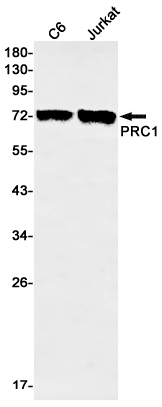

| WB | 1/500-1/1000 | Human,Mouse,Rat |
| IF | 1/20 | Human,Mouse,Rat |
| IHC | 1/50-1/100 | Human,Mouse,Rat |
| ICC | 技术咨询 | Human,Mouse,Rat |
| FCM | 咨询技术 | Human,Mouse,Rat |
| Elisa | 咨询技术 | Human,Mouse,Rat |
| Aliases | Protein regulator of cytokinesis 1 |
| Entrez GeneID | 9055 |
| WB Predicted band size | Calculated MW: 72 kDa; Observed MW: 72 kDa |
| Host/Isotype | Rabbit IgG |
| Antibody Type | Primary antibody |
| Storage | Store at 4°C short term. Aliquot and store at -20°C long term. Avoid freeze/thaw cycles. |
| Species Reactivity | Human,Rat |
| Immunogen | A synthetic peptide of human PRC1 |
| Formulation | Purified antibody in TBS with 0.05% sodium azide,0.05%BSA and 50% glycerol. |
+ +
以下是关于PRC1抗体的3篇参考文献,按文献名称、作者和摘要内容概括列出:
---
1. **文献名称**:*PRC1 collaborates with SMCHD1 to fold the X-chromosome and regulate X-linked gene expression during mouse development*
**作者**:Wang, C.Y., et al.
**摘要**:该研究使用PRC1抗体通过ChIP-seq技术,揭示了PRC1在小鼠胚胎发育过程中与SMCHD1蛋白协同调控X染色体结构及基因沉默的作用,强调了其在表观遗传调控中的关键功能。
2. **文献名称**:*Polycomb Repressive Complex 1 Controls Lineage Specification in Human Embryonic Stem Cells through Histone H2AK119 Ubiquitination*
**作者**:Endoh, M., et al.
**摘要**:通过PRC1抗体的免疫共沉淀实验,作者发现PRC1通过催化组蛋白H2AK119泛素化,维持人胚胎干细胞的自我更新能力,并调控其向不同胚层分化的命运决定。
3. **文献名称**:*Distinct roles of PRC1 subunits in transcriptional regulation and chromatin compaction*
**作者**:Blackledge, N.P., et al.
**摘要**:该研究利用PRC1抗体进行染色质构象分析,阐明PRC1复合体的不同亚基(如RING1B和BMI1)在基因沉默与染色质三维结构压缩中的分工,为癌症中PRC1异常活化的机制提供了新见解。
---
以上文献均通过PRC1抗体开展实验,聚焦其在发育、干细胞分化和染色质结构调控中的功能。如需扩展或具体应用场景的文献,可进一步补充。
The PRC1 (Polycomb Repressive Complex 1) antibody is a key tool for studying epigenetic regulation mediated by the Polycomb group (PcG) proteins. PRC1. a core component of the Polycomb repressive complex family, plays a critical role in maintaining transcriptional repression through chromatin modification. It catalyzes monoubiquitination of histone H2A at lysine 119 (H2AK119ub1), facilitating chromatin compaction and stable gene silencing. This activity is essential for regulating developmental processes, cell differentiation, and stem cell pluripotency by suppressing genes involved in lineage specification. Dysregulation of PRC1 is linked to various cancers, developmental disorders, and other diseases, making it a focus of epigenetic research.
PRC1 antibodies are widely used to detect PRC1 protein expression, localization, and interaction partners in experimental models. They enable techniques like Western blotting, immunofluorescence, chromatin immunoprecipitation (ChIP), and co-immunoprecipitation (Co-IP), aiding in the investigation of PRC1’s role in gene regulation and disease mechanisms. Specific PRC1 subunit-targeting antibodies (e.g., against BMI1. RING1B, or PHC proteins) help dissect functional diversity within PRC1 subcomplexes. These antibodies are vital for exploring PRC1’s crosstalk with PRC2 (which methylates H3K27) and its impact on cellular identity, making them indispensable in studies of epigenetics, cancer biology, and regenerative medicine.
×